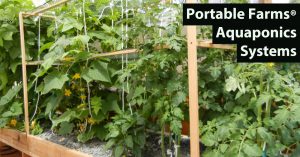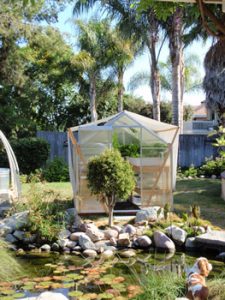The Economics of Aquaponics
By Colle and Phyllis Davis, Inventors, Portable Farms® Aquaponics Systems
The information in this article focuses on the economics of aquaponics. We explore the financial aspects as well as people’s desire to learn about the aquaponics technology that allows them to grow food year-round.
PFAS LLC has offered our Portable Farms® Aquaponics Systems
for sale to the public since June 2008.
- We have sold both backyard farms and commercial farms in 25 countries, all 50 US States and throughout Canada.
- We have also conducted private tours of our farms to more than 7,000 people who traveled from all over the world to see our technology and the food and fish we grow.
A small backyard aquaponics installation is not a good investment from a business standpoint. For example, if you were interested in growing and selling the food from your aquaponics system, the ROI (Return on Investment) would be 5 to 10 years or even longer. It’s a wise move to invest money where you receive a faster rate of return. On the other hand, the value of your installation increases each year even if you sell none of the productionJun
Backyard Aquaponics Systems
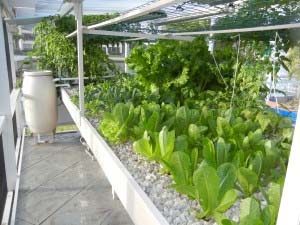 Those who buy a Portable Farms Aquaponics Course and Kit or build their own style system are interested in the following factors.
Those who buy a Portable Farms Aquaponics Course and Kit or build their own style system are interested in the following factors.
- They want to learn about aquaponics growing. [Many have an interest in expanding their backyard farm into a larger operation with the idea of selling their produce and fish. For those, we recommend a minimum of ten Portable Farms® modules 5’x40’ or 6’x32’ to create a reasonable ROI for their time and investment.]
- They want to involve family members in a hobby that teaches everyone the process of growing vegetables and raising fish.
- They are interested in growing fresh, healthy and delicious food year-round to become more self-sufficient and sustainable.
- They want to share their interest in aquaponics with family, neighbors and friends. Did someone mention bragging rights? Yes, they did.
The Economics of a Family-Sized Aquaponics Greenhouse
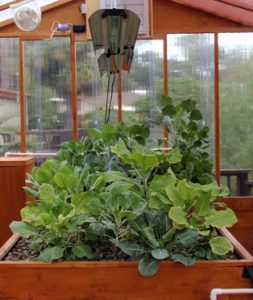 The highest cost of a backyard yard aquaponics system is the greenhouse structure. If year-round production is the goal, then a climatically adapted structure will be 60% to 70% of the total cost. Building a food-protection facility for your family is expensive, but the payback is worth the investment.
The highest cost of a backyard yard aquaponics system is the greenhouse structure. If year-round production is the goal, then a climatically adapted structure will be 60% to 70% of the total cost. Building a food-protection facility for your family is expensive, but the payback is worth the investment.- The cost of a head or bunch of lettuce in the summer is low because it is readily available from many sources. The cost of that same head/bunch of lettuce in the winter can be up to three times the summer cost.
- How valuable is having your produce fresh and available year-round? What dollar value is there in knowing the routine is to plant, harvest, and feed the fish—no weeding, no spraying, no insects, no rotting vegetables.
- The ROI on a backyard family aquaponics farm is difficult to measure in terms of money. It is easy to understand the value of enjoying the best food on the planet readily available. A small solar electrical system and some supplemental heat means you can survive most disasters. There is a satisfaction in knowing you are providing for your family even in hard times.
Commercial Aquaponics Installations
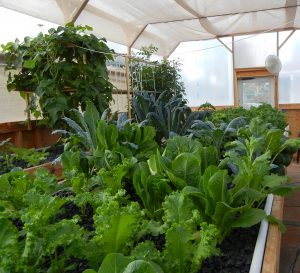 On a larger scale, commercial installations (3,000+ sq. ft / 279 m2) have an ROI’s in the one-to-three-year range depending on these factors:
On a larger scale, commercial installations (3,000+ sq. ft / 279 m2) have an ROI’s in the one-to-three-year range depending on these factors:
- The successful operation of a commercial sized farm is dependent on the skill of managers and operators of the farm.
- The choice of seeds and crops (vegetables and fish) they grow in their farms.
- The marketing skills of the manager of the farms to sell and deliver the food to their customers in a timely manner so the food is harvested and delivered at the peak of perfection.
- The success of the structure (greenhouse) to 1) maintain moderate growing temperatures, 2) provide safety and growing-level conditions within the farm to protect the plants from weather, birds, insects and other predators (squirrels, etc.), 3) a minimum of six hours of direct sunlight per day, 4) Plants can only utilize approximately 70% of direct sunlight. Shade cloth is vital for crop protection for UV and heat sensitive plants.
The larger the facility, the faster the payback. Several large installations will pay themselves off at a rate that allows the income to fund more installations.
Caveat: This article is not about commercial aquaponics, if you want more information read our definitive book on the subject, Commercial Aquaponics GOLD .
Greenhouses to House Your Backyard Aquaponics System
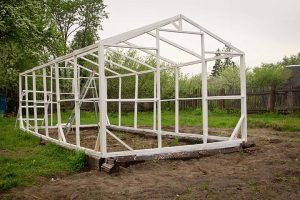 This 10′ x 16′ greenhouse frame is large enough to hold one 5′ x 12′ grow table
This 10′ x 16′ greenhouse frame is large enough to hold one 5′ x 12′ grow table
capable of feeding two people table vegetables FOREVER.
Assuming you are ready to build the greenhouse, the next step is where to place it. The building needs 6 hours of direct sunlight each day for the best results. Or you will need supplemental lighting to reach full production levels. Shade cloth is also necessary and made movable to maximize the growing season.
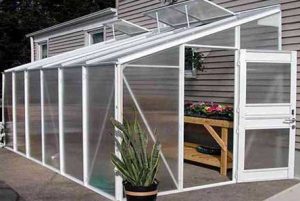 If you’re interested in a lean-to greenhouse on the side or back of your house, we’ve provided a link to a free plan and tutorial at the bottom of this page.
If you’re interested in a lean-to greenhouse on the side or back of your house, we’ve provided a link to a free plan and tutorial at the bottom of this page.
- South of the 37th parallel latitude, (Mason/Dixon line in the US) the best results are realized using a north/south orientation of the long measurement of the building. This layout spreads the sun over the interior more effectively and makes the use of shade cloth more efficient.
- North of the 37th parallel, it is best to use an east/west long measurement to build on. This layout allows for more insulated areas and better heating in the winter. It also makes cooling more efficient in the summer because of the prevailing wind direction.
The ROI on backyard aquaponics systems is immeasurable. They have an intrinsic value to you and your family. Knowing food is available, having some long-term storage foods as a backup, and knowing how to fix nutritious meals for loved ones brings peace and satisfaction in these troubled times.
- How to build a lean-to greenhouse: https://howtospecialist.com/garden/greenhouse/how-to-build-a-lean-to-greenhouse/

